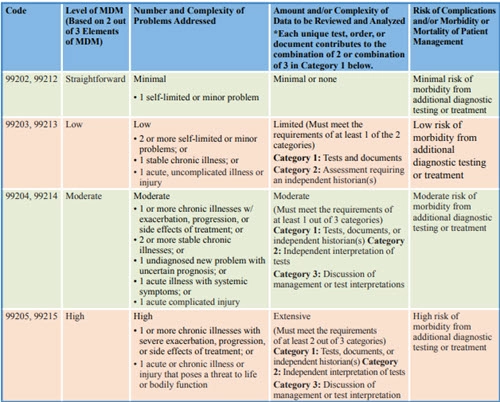Keep Modifier 25 Rules Straight With New E/M Rules
Remember to maintain stringent documentation standards in 2021. There’s going to be a lot for coders to get used to next year when it comes to office evaluation and management (E/M) coding. They’ll have to choose an E/M code based on medical decision making (MDM) or time alone, and the descriptors for each of the office visit codes are changing. Not only that, but you have to consider how the new rules are going to affect how you report separate E/Ms with modifier 25 (Significant, Separately Identifiable Evaluation and Management Service by the Same Physician or Other Qualified Health Care Professional on the Same Day of the Procedure or Other Service) on the same day as the minor procedure. Don’t worry: During her recent presentation at HEATLHCON 2020 Regional Virtual Conference: “E/M Guidelines 2021 — Office Visits With Minor Procedures,” Lori A. Cox, MBA, CPC, CPMA, CPC-I, CEMC, CGSC, CHONC, walked attendees through how the changes might affect modifier 25 use. Remember Built-In Surgical E/M Component Cox reminded coders that you need to prove a separate E/M before reporting it with modifier 25. “All procedures have a component of E/M in them: decision for surgery, pre-and postop work. Also, 90 percent of the minor procedures in the CPT® book already have a component of E/M built in to that procedure. So modifier 25 use has to be backed with a good case for a separate E/M,” she continued. Cox also showed coders the definition of modifier 25 in the CPT® book and pointed out two very important components: Separately identifiable and above and beyond. You need to identify the E/M as both of these before considering coding it. In order to pick out a separately identifiable E/M service, you’ll need valid documentation. Some keywords that might translate into an E/M-25 include: Meet M.E.A.T: You can use the acronym M.E.A.T. to check if your provider performed a separately identifiable E/M service separate from a minor procedure, Cox said. You should ask yourself the following questions about the encounter before deciding on an E/M-25: Did the provider Manage, Evaluate, Address, or Treat something separate from the work involved in the minor procedure? If so, you should be able to report an E/M with modifier 25 separate from the procedure. All of this has to be spelled out in the documentation, Cox added, before telling listeners that their documentation of the E/M-25 should include: Warning: Do not use modifier 25 when there is an E/M with a same-day procedure with a major (90-day) global, when the decision is made 24 hours prior to surgery. That is for modifier 57 (Decision for surgery). Use This Chart to Gauge MDM E/M Decision If you’re coding based on MDM in 2021, you’ll choose MDM as per the AMA chart: “CPT® E/M Office Revisions Level of Medical Decision Making (MDM).” (To see the decision chart, turn to page 3.) Note: These MDM rules only apply to codes 99202 (Office or other outpatient visit for the evaluation and management of a new patient, which requires a medically appropriate history and/or examination and straightforward medical decision making …) through 99215 (Office or other outpatient visit for the evaluation and management of an established patient, which requires a medically appropriate history and/or examination and high level of medical decision making …). These are the descriptors for codes in 2021, not 2020, so don’t go looking to match them the codes in your current CPT® book. As it is being deleted in 2021, 99201 (Office or other outpatient visit for the evaluation and management of a new patient, which requires these 3 key components: A problem focused history; A problem focused examination; Straightforward medical decision making …) is a non-issue. For other E/M services — hospital inpatient, observation, etc. — continue to use the same rules as 2020 for code selection.



